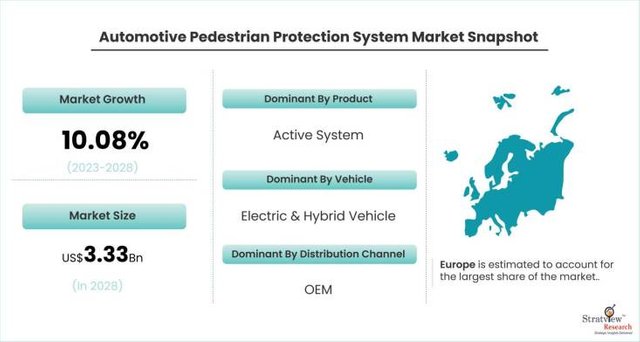Navigating Market Dynamics in the Automotive Pedestrian Protection System Industry
The automotive pedestrian protection system industry is expanding rapidly, driven by increasing global awareness of road safety, stricter regulations, and advancements in sensor and automotive technology. These systems, which are designed to detect, prevent, or mitigate accidents involving pedestrians, have become integral in modern vehicles as safety takes center stage in automotive design. Understanding the key dynamics influencing this market is essential for stakeholders seeking to capitalize on the industry's growth opportunities.
According to Stratview Research, the automotive pedestrian protection system market was estimated at USD 1.86 billion in 2022 and is likely to grow at a CAGR of 10.08% during 2023-2028 to reach USD 3.33 billion in 2028.

1. Stringent Safety Regulations and Policies
Government mandates on vehicle safety have played a significant role in driving the pedestrian protection system market. Regions such as Europe and North America have enforced strict safety requirements, pushing automotive manufacturers to integrate pedestrian protection systems. For example, the European New Car Assessment Programme (Euro NCAP) awards safety ratings based on the inclusion of pedestrian safety features. As regulatory bodies worldwide adopt similar measures, the demand for pedestrian protection systems is expected to rise steadily, impacting both market dynamics and competition among automotive manufacturers.
2. Technological Advancements in Detection Systems
Recent advancements in detection technologies, such as radar, lidar, and camera-based systems, have been pivotal in enhancing pedestrian protection system effectiveness. These technologies allow pedestrian protection systems to detect pedestrians more accurately and respond faster, reducing the likelihood of collisions. Innovations in artificial intelligence (AI) and machine learning have further empowered these systems to make quicker, more accurate decisions in complex urban environments. With autonomous and semi-autonomous vehicle technologies on the horizon, these intelligent detection systems are poised to become standard in modern automotive design, driving market growth.
3. Rising Urbanization and Traffic Congestion
Urban areas are seeing higher pedestrian traffic, resulting in increased chances of vehicle-pedestrian interactions. As more people move into cities and rely on walking as a primary mode of transportation, the need for effective pedestrian protection systems intensifies. Increased urbanization, particularly in Asia-Pacific regions, has spurred investments in safety systems designed for congested road conditions, expanding the pedestrian protection system market’s geographical reach.
4. Consumer Demand for Enhanced Safety Features
As consumers become more safety-conscious, there is growing demand for vehicles equipped with advanced protective features. Many consumers now view pedestrian protection system as essential, influencing automakers to prioritize these systems to stay competitive. This consumer-driven trend is encouraging car manufacturers to invest in pedestrian protection system research and development, further driving industry growth.
Conclusion
The automotive pedestrian protection system industry is propelled by regulatory pressure, advancements in detection technologies, urbanization, and increasing consumer awareness. Navigating these dynamics requires automotive stakeholders to remain agile and prioritize innovation. As the industry continues to evolve, pedestrian protection system will likely become a critical component in vehicle safety, shaping the future of road safety and transforming the automotive landscape.